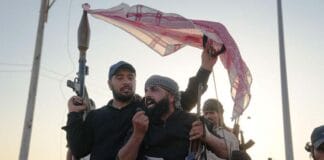There was renewed talk of Western military intervention into Syria following the Houla massacre in May and the downing of a Turkish military jet in June. “All options are on the table” declared UK Foreign Secretary William Hague.
The Western media presents Syria as a civil war with the revolutionaries hopelessly outgunned and the Syrian people just passive victims. This helps make the case for Western intervention. But despite Assad’s ruthless efforts to crush them and the terrible scale of the killing, mass protests have continued throughout recent months and put the revolution back on the front foot.
There are demonstrations right across Syria every week. Importantly many of these take place in the suburbs of Syria’s two largest cities, Damascus and Aleppo, once considered strongholds of the regime.
“In both places we’ve seen not just more armed clashes than ever in the past, but also a revival of the protest movement in its peaceful dimension,” said Peter Harling from the International Crisis Group.

Merchants in central Damascus shut down the entire Hamidiya Bazaar in May in response to the Houla massacre. There have also been successful student and merchant strikes in Aleppo, as well as the largest protests there to date, as thousands attempted to march on the city centre.
Defections
This has given confidence to an increasing number of soldiers to defect. At the end of June a general, five officers and 33 soldiers crossed the border into Turkey. In early July another 85 soldiers including a general defected. General Manaf Tlass, part of Assad’s inner circle, followed days later. Significant parts of Syria have now become de facto safe havens for defectors.
There are signs too of Minority Alawite Muslims starting to abandoned the regime. An Alawite captain formed the “Free Alawites” within the Free Syrian Army in March and in June another small group of Alawite soldiers defected saying, “we oppose this criminal regime and its brigades”.
These defections are important because Assad’s power rests on elite military units that are entirely Alawite, as are many leading members of the regime. Assad uses sectarianism to keep these units loyal, arguing that if he falls there will be pogroms directed at the Alawites and other minorities.
This is why the next step in the revolution is political not military. The revolutionaries have to convince the Alawites and other minorities that there is a place for them in the new Syria. Emphasising the class divide between rich Alawites around the regime and the majority of Alawites can help to do this.
Western intervention
While Western powers are cautious about military intervention for fear of being drawn into another quagmire, they are currently backing UN envoy Kofi Annan’s “peace plan”. This—like direct military intervention—is not in the interests of the Syrian people. It involves only minimal change. Annan wants to convince Russia, for the sake of regional stability, to help impose a “negotiated settlement” to push Assad aside. The rest of his murderous regime would remain, with a new leader at the top.
The “peace plan” will most likely fail as Russia believes without Assad its influence will decline, and the revolutionaries in Syria are unlikely to accept cosmetic change.
There is confusion amongst anti-war activists about how to respond. Some witness the brutality of the regime and call for Western-led “humanitarian intervention”. But the West isn’t motivated by humanitarian concerns but by its own strategic interests.
Others see the need to oppose Western intervention but feel compelled to denigrate the revolution. They argue it has been “manufactured” by the West as an excuse to remove Assad, an obstacle to Western policy in the region.
No doubt the Western powers have been meddling in the uprising. But it remains a genuine struggle of the Syrian masses. It began with protests in Deraa after children were arrested for painting up anti-Assad slogans. Assad responded with violence and the protests escalated. People have only taken up arms to defend themselves and the majority of arms and personnel have come from defecting soldiers.
While Assad has been an enemy of the West, he has been a predictable enemy. Israel’s border with Syria has remained secure because Assad polices it with an iron fist. His support for anti-imperialist movements in Palestine and Lebanon has been inconsistent.
But we should reject the idea that if you oppose Western intervention you must support Assad. The West fears a successful revolution more than it fears Assad. We should oppose Western intervention and support the revolution against its two enemies, Assad and the West.





